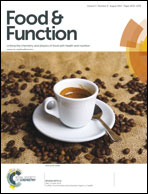Attenuated migration by green tea extract (−)-epigallocatechin gallate (EGCG): involvement of 67 kDa laminin receptor internalization in macrophagic cells†
Abstract
Excessive activation of the microglia in the brain is involved in the development of several neurodegenerative diseases. Previous studies have indicated that (−)-epigallocatechin gallate (EGCG), a major active constituent of green tea, exhibits potent suppressive effects on the activation of microglia. As the 67 kDa laminin receptor (67LR) is a key element in cellular activation and migration, we investigated the effect of EGCG on cell migration and 67LR in lipopolysaccharide (LPS)-activated macrophagic RAW264.7 cells. The presence of EGCG (1–25 μM) markedly attenuated LPS-induced cell migration in a dose-dependent manner. However, the total amount of 67LR protein in the RAW264.7 cells was unaffected by EGCG, as revealed by Western blot analysis. In addition, confocal immunofluorescence microscopy indicated that EGCG caused a marked membrane translocation of 67LR from the membrane surface towards the cytoplasm. Cell-surface biotinylation analysis confirmed that EGCG induced a significant internalization of 67LR by 24–68% in a dose-dependent manner. This study helps to explain the pharmacological action of EGCG on 67LR, suggesting its potential use in the treatment of diseases associated with macrophage/microglia activation, such as neurodegenerative diseases and cancer.


 Please wait while we load your content...
Please wait while we load your content...